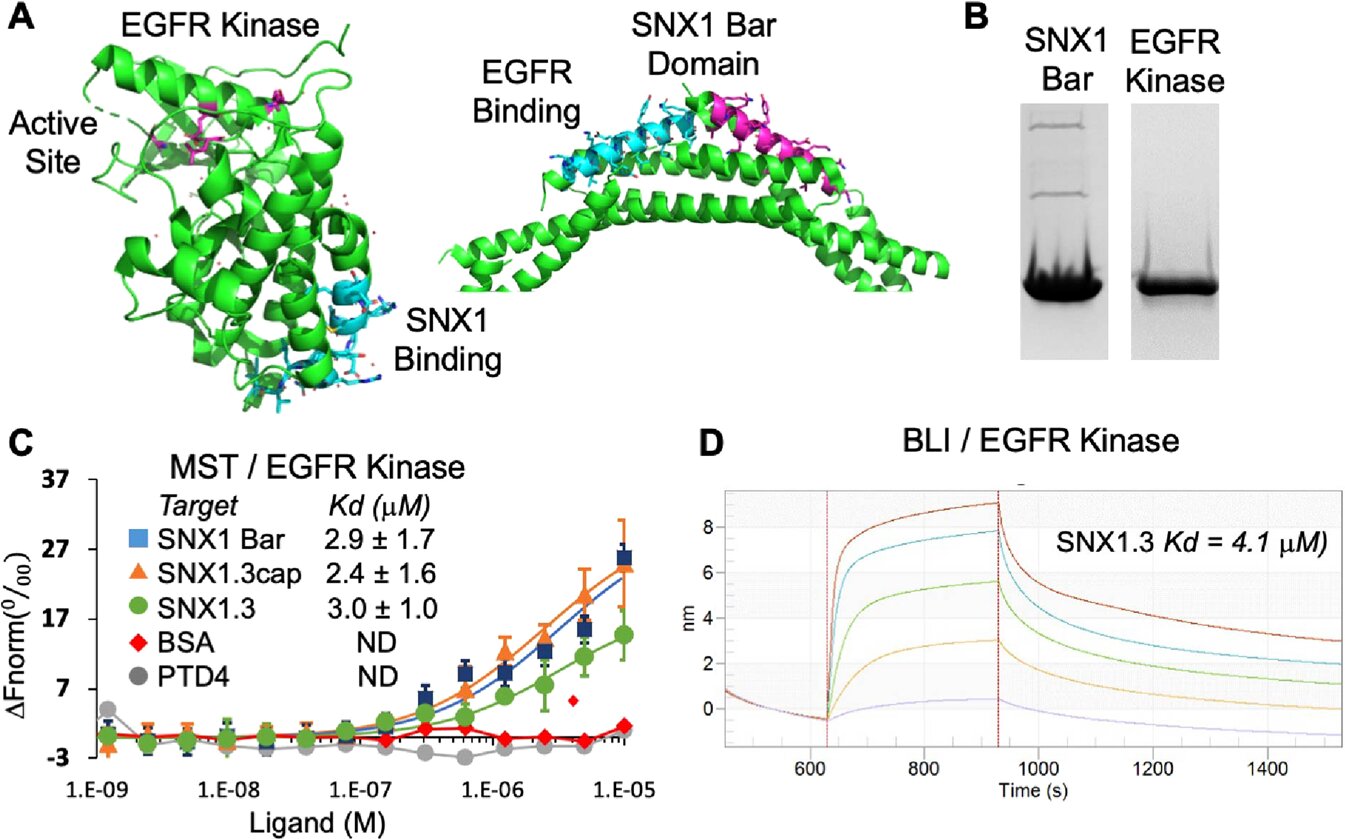
Researchers develop ‘Goldilocks drug’ to treat triple-negative breast cancer
cSNX1.3 competitively inhibits EGFR binding to SNX1. A Ribbon drawing of EGFR kinase domain (PDB ID 5CNO) and SNX1 Bar domain (PDB ID 4FZS). The proposed SNX1 binding site is located far from the active site of the kinase. B SDS page gels for purified SNX1 Bar domain (residues 301–522) and EGFR kinase domain (residues 672–998). S MST binding curves of EGFR kinase domain (50 nM) with fluorescent dye attached via His tag, titrated Bar domain, peptides SNX1.3 (closed), SNX1.3 and control PTD4, and control BSA. D Binding of SNX1.3 to the kinase domain was also measured by biofilm interferometry (Octet BLI), which yielded a dissociation constant similar to that measured by MST. credit: Gene therapy for cancer (2022). DOI: 10.1038/s41417-022-00541-7
After decades of research and two previous attempts at drug development, a team of University of Arizona researchers working on a less toxic treatment for a certain type of breast cancer is looking promising.
Researchers have developed a drug that appears to stop growth of cancer cells in what is known as triple negative breast cancer. The drug, which has not yet been tested in humans, has been shown to eliminate tumors in mice with little to no effect on normal, healthy cells, making it potentially non-toxic to patients.
The therapy is based on a recently discovered method of a gene known as epidermal growth factor receptor, or EGFR, leads to cancer. EGFR is a long-researched oncogene – a gene that, under certain circumstances, can transform a cell into a tumor cell.
The researchers’ findings are published in the journal Gene therapy for cancerand the team is working to get Food and Drug Administration approval to test the compound in Phase 1 human clinical trials.
Triple-negative breast cancer accounts for approximately 10 to 15% of all breast cancers. Triple negative refers to the fact that the cancer cells test negative for three other types of breast cancer — those caused by too much estrogen, too much progesterone, or too much of a protein called HER2, according to the American Cancer Society. Triple-negative breast cancer is more common in black women under the age of 40 or in women who have a specific mutation in a gene called BRCA1. According to the National Institutes of Health, about half of all triple-negative breast cancers overexpress the EGFR oncogene.
UArizona researchers have developed a compound that blocks EGFR from moving to the part of the cell that keeps cancer alive. The compound stops the function of the EGFR protein, which works in cancer cells but not in normal cells.
Often the drugs are not targeted enough and will therefore attack parts of other healthy cells, leading to unwanted side effects. Researchers wanted to prevent this.
“EGFR has been known to be an oncogene for six decades, and there have been many drugs trying to target it, but they all had limitations that made them unsuitable as breast cancer drugs,” said Joyce Schroeder, who co-authored the paper with lead author Benjamin Atwell, a doctoral student in the Department of Molecular and Cell Biology.
Schroeder chairs the university’s Department of Molecular and Cell Biology and runs the laboratory where the research for the paper was conducted. She is also a member of the BIO5 University Institute and Cancer Center.
The first two drug technologies she and her team created worked to kill cancer cells, but they had problems.
In their first attempt, the researchers targeted what Schroeder called the “unstructured” part of the EGFR protein, and as a result, the compound could not work consistently and reliably.
The second attempt resulted in a compound that was too general and hit a part of a protein that also ensured normal activity in healthy cells, making the drug toxic.
To be effective, Schroeder and her team knew they had to develop a compound that could enter a cancer cell and target the right part of the proteins made by the EGFR gene to stop the cancer from spreading. They succeeded on the third attempt.
“It was like the Goldilocks effect,” Schroeder said.
She and her team knew they needed to find a solution that would not affect the normal cell and remain active in the body.
“When we tested the drug in animal models, we had an amazing result where it didn’t just stop tumors from growing, but caused them to regress and disappear, and we didn’t see any toxic side effects,” she said. . “We’re very excited about that because it’s very specific to the tumor.”
Like designing a key that fits a very specific lock, molecular and cellular biologists ideally design drug chemistries that will interact with target protein the right way and nothing else.
“Targeting triple-negative breast cancer has been challenging because it doesn’t have any of those obvious things,” Schroeder said. “People have known for a long time that triple-negative breast cancer cells express EGFR, but when known EGFR drugs were thrown at them, they didn’t respond.”
Many researchers thought that maybe EGFR shouldn’t be a target, so they looked for new ones. Schroder, on the other hand, believes that EGFR simply works in ways that researchers don’t yet understand. She and her team tried to target it in a new way, with success.
The next step, beyond human trials, is to test the drug’s ability to suppress metastases that occur when cancer cells has spread to other parts of the body, Schroeder said.
Researchers worked on protection intellectual property and further invest in licensing assets to Tech Launch Arizona, the university’s office that commercializes university innovation.
Benjamin Atwell et al., Sorting out nexin-independent therapeutic targeting of the oncogenic epidermal growth factor receptor, Gene therapy for cancer (2022). DOI: 10.1038/s41417-022-00541-7
Provided
University of Arizona
Citation: Researchers develop ‘Goldilocks drug’ to treat triple negative breast cancer (October 25, 2022) retrieved October 25, 2022 from https://medicalxpress.com/news/2022-10-goldilocks-drug-triple-negative- breast-cancer .html
This document is subject to copyright. Except in good faith for the purpose of private study or research, no part may be reproduced without written permission. The content is provided for informational purposes only.


